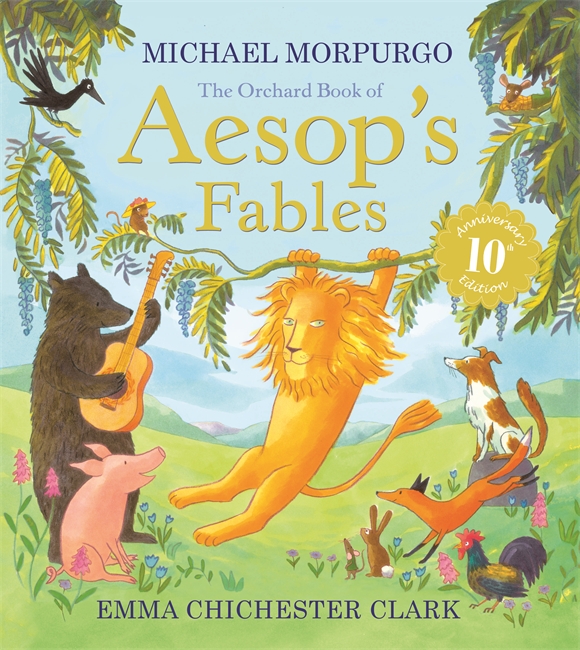Title of the work
Country of the First Edition
Country/countries of popularity
Original Language
First Edition Date
First Edition Details
Michael Morpurgo, The Orchard Book of Aesop's Fables. London: Orchard Books, imprint of Hachette Children's Group, 2004, pp. 96
ISBN
Genre
Fables
Picture books
Short stories
Target Audience
Children (aged c. 4–8)
Cover

"The Orchard Book of Aesop's Fables" by Michael Morpurgo, illustrated by Emma Clark Chichester, cover reproduced by permission of (imprint), the Hachette Children's Group, Carmelite House, 50 Victoria Embankment, London EC4Y 0DZ.
Author of the Entry:
Sonya Nevin, University of Roehampton, sonya.nevin@roehampton.ac.uk
Peer-reviewer of the Entry:
Susan Deacy, University of Roehampton, s.deacy@roehampton.ac.uk
Elżbieta Olechowska, University of Warsaw, elzbieta.olechowska@gmail,.com

Courtesy of the Author.
Emma Chichester Clark
, b. 1955
(Illustrator)
Emma Chichester Clark is a British children's illustrator. Chichester Clark has been writing since she was five. She grew up in the Irish countryside and started illustrating at age 16. She trained in Graphic Design at the Chelsea School of Art. Originally rejected from the Royal College of Art, she began to focus on adult narrative work and, once accepted at the RCA, she switched back to illustrating children’s books. As well as collaborating with authors, Chichester Clark writes and illustrates her own picture books, notably the highly successful Blue Kangaroo series (Andersen Press Ltd.). She also won the Mother Goose Award as the most exciting newcomer to children's book illustration in 1988 for her illustration of Listen to This (1987). Chichester Clark is also writing and illustrating her own children’s books while collaborating with other authors.
Sources:
Official website (accessed: July 4, 2018).
Profile at the literature.britishcouncil.org (accessed: July 4, 2018).
Bio prepared by Allison Rosenblum, Bar-Ilan University, allie.rose89@gmail.com and Sonya Nevin, University of Roehampton, sonya.nevin@roehampton.ac.uk

Michael Morpurgo
, b. 1953
(Author)
Michael Morpurgo (1953- ) is an acclaimed British children's author, poet, playwright, and librettist. He worked as a teacher for ten years before going on to establish the charity Farms for City Children, with his wife Clare Morpurgo (also a teacher). They were both awarded the MBE for "services to youth" in 1999. Since becoming a children's author, Morpurgo has written over a hundred titles, often on historical themes. War Horse was adapted for stage and film, while Private Peaceful features in the UK school curriculum. Titles addressing traditional stories include: Outlaw: The True Story of Robin Hood; Sparrow: The True Story of Joan of Arc; Beowulf; Sir Gawain and the Green Knight; and The Sleeping Sword. Michael Morpurgo was UK Children's Laureate 2003-5, and in 2006 he was awarded the OBE for "services to literature".
Source:
Official website (accessed: May 29, 2018).
Bio prepared by Sonya Nevin, University of Roehampton, sonya.nevin@roehampton.ac.uk
Summary
Fables attributed to Aesop were collated in antiquity by Demetrius of Phaleron, c. 300 BCE (Diogenes Laertius, 5.80), and passed on through various retellings in antiquity and the medieval, early modern, and modern periods. This highly illustrated story-book contains retellings of a selection of Aesop's Fables for a young audience. Contents:
- For Mr Aesop from Mr Morpurgo, a Thank-You (An introduction to the collection).
- The Lion and the Mouse
- The Hare and the Tortoise
- The Dog and his Bone
- The Crow and the Jug
- Belling the Cat
- The Cockerel and the Fox
- The Travellers and the Bear
- The Wind and the Sun
- The Lion and the Fox
- The Goose that Laid the Golden Egg
- The Rat and the Elephant
- The Heron and the Fish
- The Dog in the Manger
- The Miller, his Son, and the Donkey
- The Oak Tree and the River Reeds
- The Fox and the Crow
- The Wolf and the Donkey
- The Sheep and the Pig
- The Peacock and the Crane
- The Town Mouse and the Country Mouse
- The Wolf and the Shepherd's Son
Analysis
This is an extremely attractive collection of highly illustrated myths. The illustrations appear across all pages, rendered in a realistic water-colour style. Details of clothing and architecture place the events in the late nineteenth/early twentieth centuries or, occasionally, a little earlier. The language used is simple yet melodic, with a lot of direct speech. The morals of the stories are re-laid explicitly beneath the end of each, not in a separate box, but in a contrasting all-capital font.
The first story, The Lion and the Mouse, finishes with the moral, "kindness is more important than strength." This would not be everybody's learning point from this story, but it does reflect aspects of the story and it fits well with messages that most adults are keen to transmit to modern children. The Crow and the Jug combines an expression with follow-up guidance: 'Where there's a will there's a way. But it helps if you use your brain.' Similarly "Fairweather friends aren’t worth having", accompanies The Travellers and the Bear. Young children may have trouble understanding the term, "fairweather friend" , much as they may struggle with, "where there's a will," but by including them the author enables children to learn idioms at the same time as they are learning stories and moral lessons. Like most collections of Aesop's Fables, this book participates in the tradition of using Greek myths to educate as well as entertain the young.
The fables' setting at the turn of the last century creates the impression that they are from the "olden days." This was perhaps intended to add to the pastoral feel of the work and to convey the sense of traditional folk wisdom being passed on. Beyond the book's title, however, there is no indication that the fables are as old as they are, or that this is "ancient" folk wisdom. Similarly, the emphasis on Northern Europe environments, as indicated by clothing and countryside, creates the impression that these stories originated in or are drawn from Northern Europe. This was perhaps intended to target a Northern European market of readers who see their own environment reflected in the stories, rather than being transported by the stories to a different country. The inclusion of occasional African (The Lion and the Mouse) or Indian (The Rat and the Elephant) settings adds diversity and the implication that the stories have resonance beyond Europe, although this element is limited by its rarity. Overall, the collection emphasises lively storytelling and the communication of morals over any explicit teaching about antiquity beyond the name, "Aesop's Fables".
There is no graphic violence in the text or illustrations, but plenty of implied violence has been kept in, giving a bite to some of the stories. Following the traditional version, the shepherd boy dies in The Wolf and the Shepherd's Son (sometimes known as The Boy Who Cried Wolf) although it is common to amend this ending so that the boy lives to learn his lesson. The Rat and the Elephant stops short of specifying the rat's grizzly end, saying, "I won't tell you what happened. You'll just have to imagine." This is balanced by a picture of the cat looking pleased with itself and sitting next to the rat's shirt, implying without stating that the rat has been eaten. The Hare and the Tortoise is told from the perspective of the observing Fox, who "laughed himself silly all the way home" at Hare's foolishness. So, while there is some emphasis on teaching children the value of kindness, the fables retain the traditional impression that the world can be a dangerous place, best navigated with a degree of caution.
Further Reading
Babrius and Phaedrus Fables, trans. B. E. Perry, Loeb Classical Library, Cambridge, MA, and London, England: Harvard University Press, 1965.
Cooper, Kenneth, "Aesop's Fables for Adults", Peabody Journal of Education 33.3 (1955): 143–147.
Daly, Lloyd, R., trans., ed., Aesop Without the Morals. The Famous Fables, and a Life of Aesop, New York: Thomas Yoseloff, 1961.
Finch, Chauncey E., "The Greek Source of Lorenzo Valla's Translation of Aesop's "Fables"", Classical Philology 55.2 (1960): 118–120.
Hall, Edith, "Our Fabled Childhood: Reflections on the Unsuitability of Aesop to Children", in Katarzyna Marciniak, ed., Our Mythical Childhood... The Classics and Literature for Children and Young Adults, Leiden: Brill, 2016.
Hall, Edith, "Aesop the Morphing Fabulist", in Owen Hodkinson and Helen Lovatt, eds., Classical Reception and Children's Literature. Greece, Rome and Childhood Transformation, London: I.B. Tauris, 2018, 89–107.
Weinlich, Barbara, "The Metanarrative of Picture Books: ‘Reading’ Greek Myth for (and to) Children", in Lisa Maurice, ed., The Reception of Ancient Greece and Rome in Children’s Literature. Heroes and Eagles, Leiden: Brill, 2015.


